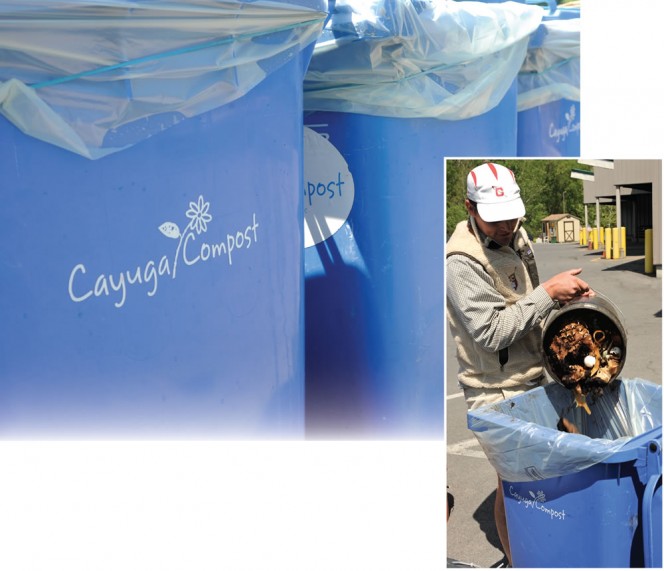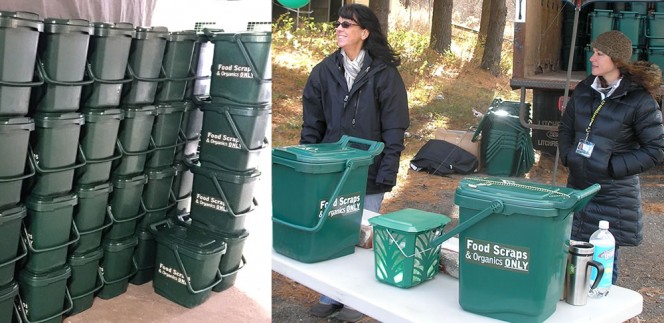Nora Goldstein
BioCycle January 2016
This is probably the best program we have created in my 26 years here,” exclaims Barb Eckstrom, Solid Waste Manager in Tompkins County, New York. Eckstrom is referring to the county’s residential food scraps Drop Spot program rolled out initially in 2012 at the county’s Recycling & Solid Waste Center (RSWC), and more recently expanded to several communities in the county. “When we look at how people think about food scraps, what is really needed is a one on one communication. That takes away questions, and gets people thinking about what is really left in their trash. And it’s a much lower cost option than curbside collection in smaller communities in terms of access to service.”

Residents bring food scraps to the Drop Spots, where they are collected and taken to Cayuga Compost. Tompkins County provides households a tool kit that includes a countertop kitchen caddy, a supply of compostable liners and a 6-gallon transport container.
Tompkins County has a population of 101,564 people living in 476 square miles. There are 41,674 households. The largest city is Ithaca, with 30,000 people. Current waste diversion is 60 percent. Tompkins County has a goal to divert 85 percent by 2030 and sees wasted food reduction and food scraps recycling as tools to help get there. It has been piloting a residential food scraps curbside collection program that started out with 450 homes in November 2013. Phase II was rolled out in May 2014, expanding the number of homes receiving food scraps collection to 1,250. A third expansion phase was scheduled for 2016 but has been cancelled. “Due to the significant loss in recycling revenues, the county will only continue funding the existing 1,250 homes through 2016,” notes Eckstrom.
The county currently has six Drop Spots, including the one at the RSWC (where residents also bring recyclables). Another is at a town highway department. Two are located at village offices, one at a Cooperative Extension office and one at Cayuga Compost, the composting facility in Trumansburg, New York that services the county’s organics diversion programs. There is no fee to use the Drop Spots. All but Cayuga Compost’s Drop Spot have an attendant. The RSWC’s Drop Spot is open Monday through Saturday from 7:30 am to 3:00 pm. The other four are open only on Saturday or Sunday for three to four hours. All food scraps as well as soiled paper are accepted. Some locations have sheds where attendants can store signage, bags and other materials needed to manage the Drop Spot.
“The attendants are there for several reasons — to answer questions, monitor contamination and educate residents about keeping contaminants out, and to offer encouragement, especially with regard to the ‘yuck factor’ associated with food scraps recycling,” explains Eckstrom. “Having attendants puts people to work at a reasonable rate for a few hours, and there are always conversations going on with the attendant as well as between people who are dropping off. The attendants are on the front line, and pass along questions they can’t answer to the county staff, who in turn respond quickly to residents.”
To help address the yuck factor and avoid contamination by receiving food scraps in conventional plastic bags, Tompkins County provides households with a free Drop Spot tool kit that includes a 2.5 gallon countertop kitchen caddy, a supply of compostable bags to use as liners, and a 6-gallon EcoSafe transport container that can sit on the floor of the backseat. Participants can restock compostable liners as needed at the Drop Spots. “The motto for the Drop Spot food scraps program is Clean, Convenient, Comfortable and Contaminant-Free,” notes Eckstrom. “Providing the supplies at no charge empowers folks to participate in a way that isn’t messy (caddy and liners). Access to Drop Spots near their residences makes participation convenient, contamination is minimized with the liners, and going to the Drop Spot with a transport container that fits neatly in their cars or can be carried is comfortable. We thought about what could go wrong and how to do things in a more clever manner. Overall, contamination is less than one percent.” About 1,800 tool kits have been given out to date.
Building On Drop-Off Behaviors
One factor Tompkins County evaluated when starting the Drop Spots was how to add food scraps to materials it already accepts at its drop-off center. “The county’s recycling program already had a very strong drop-off component,” says Eckstrom. “For example, we accept recyclables that are not allowed in the county’s curbside program. So food scraps are just another material we now take. But the characteristics of food scraps and the challenges related to contamination led us to deciding upon the free tool kit and the attendants.”
There were approximately 22,000 drops in total to the Drop Sites in 2015; the county estimates that 200 tons of food scraps and soiled paper were dropped off in 2015. Materials are transported to Cayuga Compost for processing. “It was important for us to realize that it would take time to get the tonnage we are hoping for, and that the key was how to make it easy for people so it fits into their lives,” she adds. “The idea was to start small and continue measuring. What we saw happen during 2015 is that participation was really growing in leaps and bounds — we went from 20 drops in 3 hours to almost 100 drops in 3 hours at some spots. And the system we are developing can be replicated in the county’s 16 municipalities and at other locations.” On average, residents divert about 13 lbs/week of food scraps in both the Drop Spot and curbside collection programs.
Eckstrom estimates that the cost of setting up and managing the Drop Spots is at least three times less than the curbside food scraps program. And at the Recycling & Solid Waste Center, it is about six times less given it is an existing, staffed facility. Tompkins County adopted volume-based pricing for trash service more than 20 years ago, with residents paying for solid waste collection via trash tags. Curbside recycling collection has been in place for 20 years, and a switch to single stream curbside recycling was made about four years ago. Therefore the incentive to divert via recycling to lower trash collection costs was already institutionalized prior to the opportunity to divert food scraps.
The county’s plan is to continue expanding Drop Spots to most if not all municipalities over the next few years. In addition, it recently purchased a cargo trailer that will serve as a mobile Drop Spot. “The trailer will have everything necessary to accept food scraps,” explains Eckstrom. “We will meet people where they are, for example, in the parking lots at shopping centers, making the Drop Spots accessible to more people. Free tool kits will continue to be provided to residents at the mobile sites and the Solid Waste office.”
Overall, she views the Drop Spots as a tool to provide Tompkins County residents the ability to increase household waste diversion over the next few years, without the cost of curbside food scraps collection programs. In addition, the Drop Spots are a direct point of contact for the county’s most recent initiative to educate residents about reducing the amount of food waste produced.














